To extend your shoe’s life, you can perform simple midsole compression tests at home. Remove the laces, inspect for cracks or worn areas, and press firmly into the midsole with your fingers or a small tool. Feel for softness and responsiveness; a stiff or uncompressible midsole indicates wear. Keeping an eye on these signs helps you replace shoes early, preventing injuries. Keep going to discover easy steps to accurately assess your shoe’s condition.
Key Takeaways
- Regularly remove laces and examine the midsole for visible cracks, holes, or significant thinning as signs of wear.
- Press firmly into the midsole using fingers or a small scale to assess its responsiveness and softness.
- Use a ruler or straight edge to measure the depth of compression and detect any deformation or deep impressions.
- Compare compression test results over time to identify decreased cushioning and early material fatigue.
- Monitor for increased stiffness, impact discomfort, or uneven wear patterns, indicating the need for shoe replacement.
Understanding the Role of the Midsole in Shoe Durability
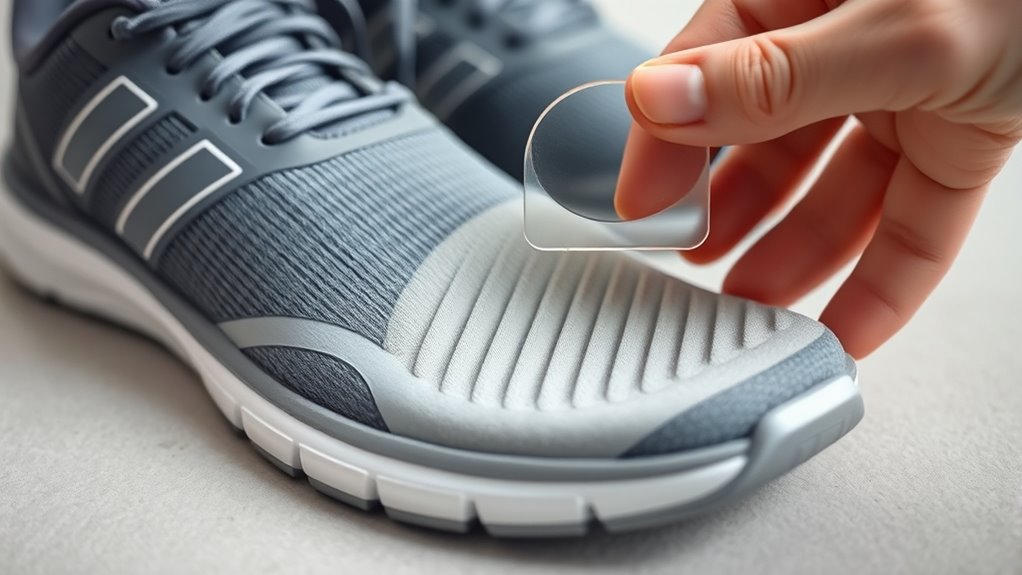
The midsole plays a crucial role in a shoe’s durability by absorbing shock and providing support during movement. The choice of midsole materials directly impacts how well your shoes perform over time. During shoe manufacturing, manufacturers select materials like EVA, polyurethane, or specialized foams to balance cushioning and resilience. These materials determine how effectively the midsole withstands compression and repeated impact. A high-quality midsole resists breaking down, maintaining support and comfort through extensive use. Understanding the importance of midsole materials helps you recognize the factors that influence shoe longevity. When designing shoes, manufacturers focus on optimizing these materials to extend durability. Additionally, the ability of the midsole to maintain its shape and function over time depends heavily on its material resilience, which is essential for extending the lifespan of your shoes. The durability of the midsole is also affected by how well it resists compression fatigue, as the material’s ability to recover after repeated compression impacts overall longevity. Proper material selection during manufacturing is crucial to prevent premature midsole failure. Furthermore, advancements in foam technology can enhance the midsole’s shock absorption capabilities, contributing to longer-lasting footwear. Ultimately, the midsole’s composition is key to ensuring your shoes can handle daily wear while protecting your feet.
Signs Your Shoes Might Be Wearing Out
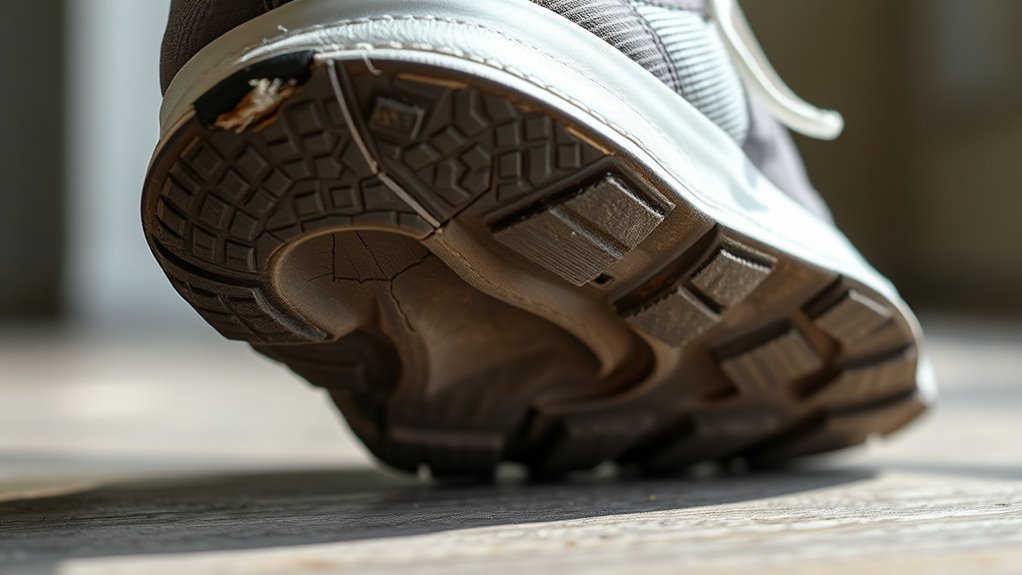
As your shoes age, signs of wear and tear become increasingly noticeable, especially if the midsole material starts to break down. One clear indicator is a reduction in sole thickness; if you notice the midsole feels noticeably thinner or compressed, it’s a sign the shoe material is deteriorating. Cracks, creases, or visible deformities in the midsole also suggest breakdown of the cushioning. Additionally, if your shoes lose their responsiveness or feel less supportive during activities, it points to worn-out midsoles. Pay attention to uneven wear patterns or areas where the shoe material appears frayed or softened. These signs indicate your shoes may no longer provide adequate shock absorption or stability, signaling it’s time to contemplate replacing them to prevent discomfort or injury. Recognizing material deterioration and changes in internal structure can also help identify internal wear that affects overall performance. Regularly performing simple compression tests at home can further assist in assessing the condition of your midsoles before they cause issues.
Gathering Simple Tools for the Compression Test
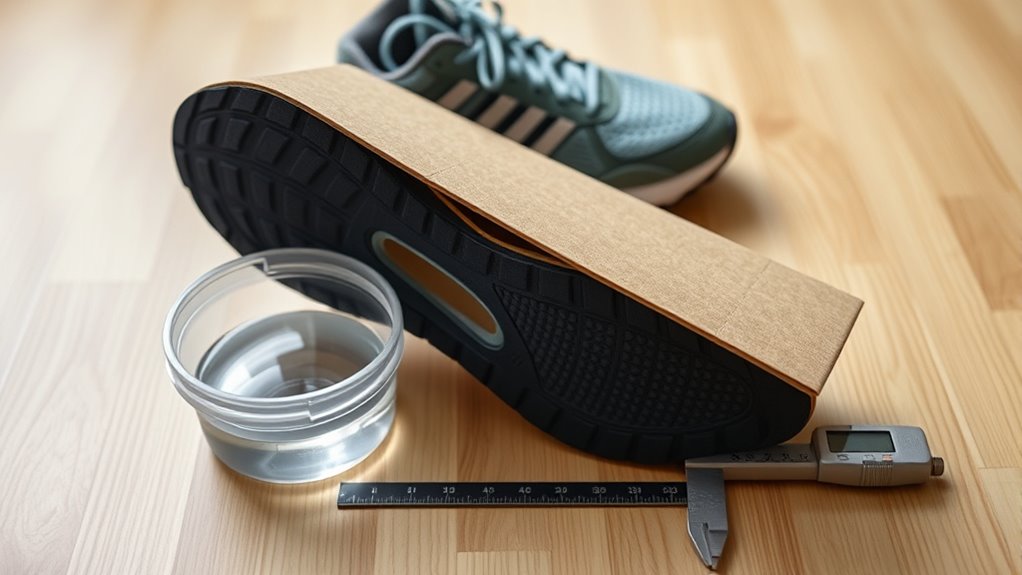
To perform a simple compression test on your shoes’ midsoles, you’ll need a few basic tools that are easy to find around the house or at a local store. A sturdy ruler or a small scale helps measure how much the midsole compacts under pressure. You might also want a pen and paper to note your observations. Additionally, understanding shoe material properties can help interpret your test results more accurately. These tools are compatible with various shoe materials and manufacturing processes, giving you insight into your shoe’s condition. Understanding the importance of consistent testing ensures more reliable assessments of your shoe’s wear over time. Regular testing can also reveal patterns in wear and tear, helping you decide when it’s time to replace your shoes or seek repairs.
Step-by-Step Guide to Performing a Midsole Compression Check
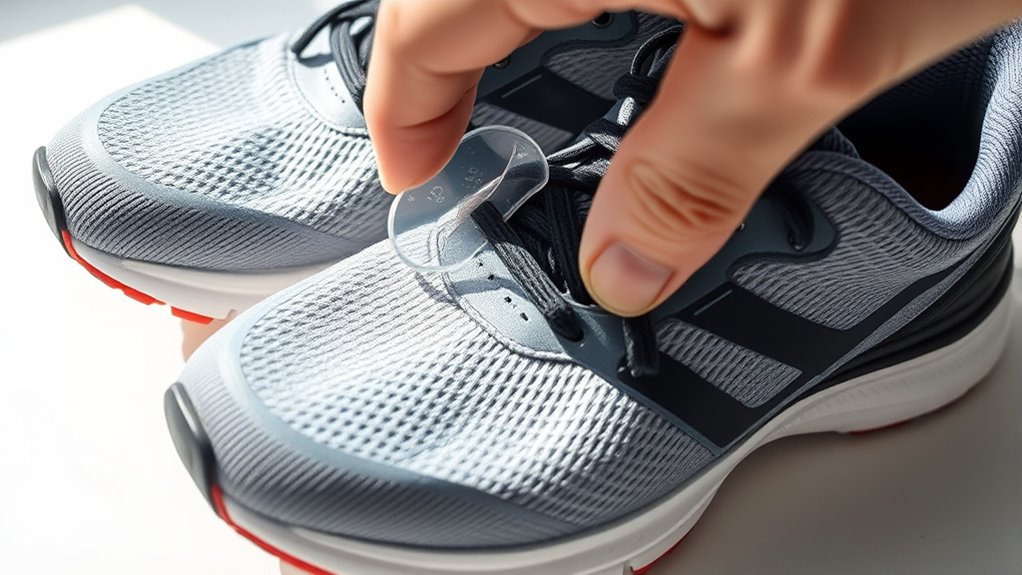
Performing a midsole compression check is straightforward if you follow a clear, step-by-step process. First, remove the shoe laces and place your shoe on a flat surface. Then, locate the heel area to assess heel cushioning and examine the outsole for any cracks or signs of wear. Next, press firmly into the midsole using your fingers or a small tool, applying even pressure across different spots. Finally, observe how the midsole responds—if it compresses easily or feels stiff, it may need replacing. Keep an eye on the heel cushioning for softness and the outsole integrity for cracks or thinning. This simple check helps you determine if your shoes still provide proper support and protection during activities.
Interpreting Your Compression Test Results
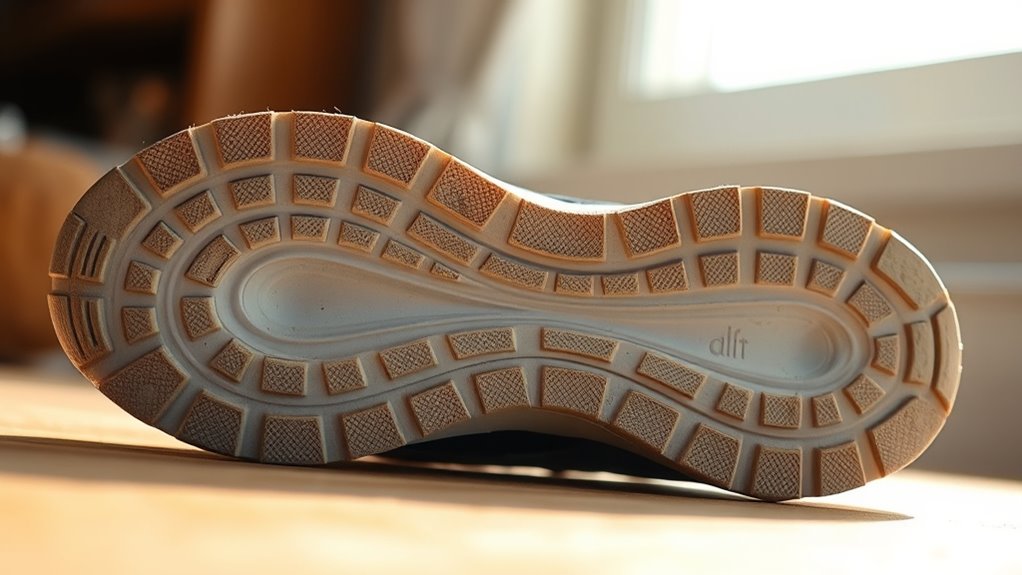
When reviewing your compression test results, start by noticing any unusual wear patterns on the midsole. Next, compare the compression levels to the manufacturer’s recommendations to see if replacement is needed. Finally, look for signs of damage, such as cracks or deep impressions, that could affect performance and comfort.
Recognizing Wear Patterns
Recognizing wear patterns in your shoe midsole is essential for understanding how your footwear performs over time. These patterns reveal how your shoe design and material selection respond to your gait and activity. Look for uneven compression, which might indicate uneven weight distribution or early breakdown. Check for creases or compression marks in specific areas—these highlight where the midsole absorbs impact most. Notice if certain spots show excessive wear compared to others; this suggests a need for better support or different materials. Additionally, fading or flattening of the midsole foam signals material fatigue. By observing these signs, you can identify whether your shoes are wearing unevenly or prematurely, helping you decide when to replace or rotate footwear for *ideal* comfort and durability.
Assessing Compression Levels
Evaluating compression levels is crucial for understanding how well your shoe’s midsole absorbs impact during use. If compression decreases markedly, it signals material fatigue, reducing shock absorption. To assess testing accuracy, compare your results over time. Here’s a simple table to help interpret your findings:
| Compression Level | Interpretation |
|---|---|
| High | Good resilience, minimal material fatigue |
| Moderate | Some fatigue, consider replacing soon |
| Low | Significant fatigue, likely needing replacement |
Consistent testing ensures you track changes accurately. Remember, as the midsole compresses and loses resilience, shock absorption diminishes, shortening shoe life. Regular assessments help you determine when to replace shoes, preventing injury and maintaining performance.
Identifying Midsole Damage
Have you ever wondered how to tell if your shoe’s midsole has sustained damage beyond normal wear? To interpret your compression test results, look for signs indicating midsole damage.
- Uneven compression: Some areas compress more than others, suggesting inconsistent shoe material or manufacturing defects.
- Excessive indentation: Deep impressions that don’t bounce back indicate compromised midsole integrity.
- Cracks or splits: Visible damage points to weakened shoe material, often caused by overuse or manufacturing flaws.
- Reduced responsiveness: If the midsole feels less springy during testing, it’s a sign the material has broken down.
Understanding these signs helps you identify early midsole damage and decide if it’s time for a replacement, especially when manufacturing defects are involved.
Tips for Maintaining Your Shoe’s Midsole Health
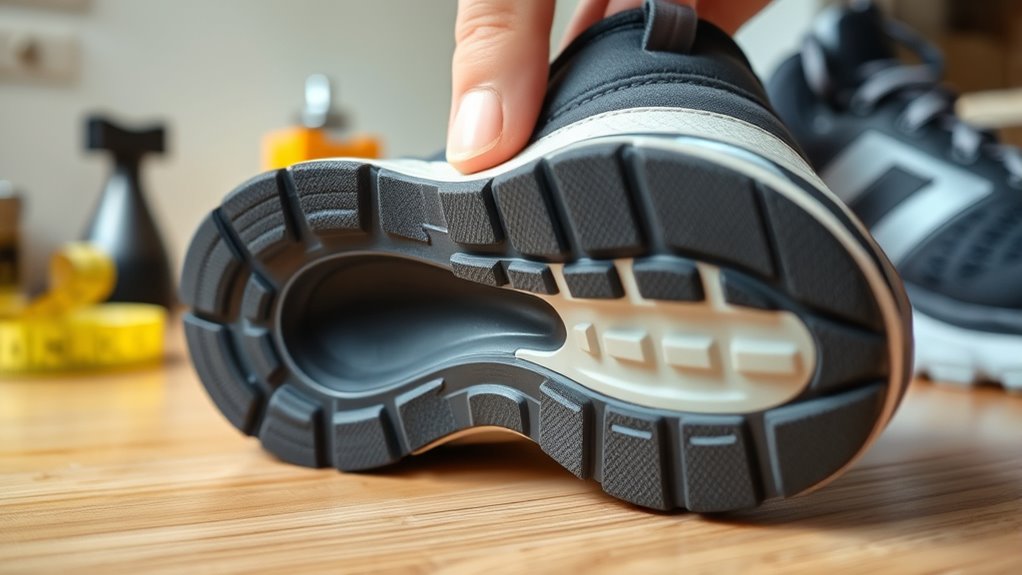
To keep your shoe’s midsole in good condition, regular maintenance is essential. Understanding midsole technology helps you care for your shoes better and extends their lifespan. During shoe manufacturing, materials are chosen for durability, but over time, they can wear down. To preserve the midsole, avoid exposing your shoes to excessive moisture or extreme temperatures, which can weaken the materials. Store your shoes in a cool, dry place and clean them gently with a soft brush or damp cloth. Rotating your shoes allows the midsole to recover from daily stress. Proper care not only maintains the integrity of the midsole but also guarantees optimal support and comfort for longer periods. Regular inspection helps catch early signs of wear, so you can act before damage worsens.
When to Consider Replacing Your Shoes

You should start thinking about replacing your shoes when you notice visible sole wear or feel more discomfort during walks or runs. If your shoes provide less cushioning or shock absorption than before, it’s a clear sign they’ve lost their effectiveness. Ignoring these signs can lead to pain or injury, so it’s best to update your footwear promptly.
Visible Sole Wear
Ever notice those tiny cracks or worn-down patches on your shoe soles? These signs of visible sole wear can indicate it’s time to replace your shoes. Check for these key indicators:
- Significant thinning or holes in high-impact areas
- Loss of material flexibility, making the sole feel stiff or brittle
- Aesthetic wear that exposes the midsole or inner layers
- Uneven wear patterns affecting balance and gait
When soles show extensive wear, the material’s ability to absorb shock diminishes, increasing discomfort and risk of injury. Aesthetic wear also affects the shoe’s appearance, making it look old and worn out. If you notice these signs, replacing your shoes can restore comfort and support, preventing further damage and ensuring safer walking or running.
Increased Discomfort Signs
As your shoes start to feel less comfortable during daily activities or workouts, it may be a sign they need replacing. Reduced midsole elasticity can cause your shoes to lose their shock absorption, leading to increased discomfort. If you notice your shoes feel stiff or less flexible than before, it indicates a decline in shoe flexibility. This stiffness often results from the midsole compressing and losing its ability to bounce back. You might experience soreness, aches, or hotspots that weren’t an issue previously. These signs suggest that the shoe’s cushioning and support are compromised. When discomfort persists even after adjusting your stride or trying different lacing techniques, it’s time to think about a replacement. Addressing these discomfort signs early can help prevent injury and maintain ideal foot health.
Reduced Cushioning Impact
When your shoes no longer absorb shock effectively, it’s a clear sign that the cushioning has diminished. This reduced cushioning impact indicates significant cushioning breakdown in the midsole material and signals it’s time to contemplate replacing your shoes. You might notice:
- Increased jarring with each step during runs or walks
- Persistent soreness or fatigue in your legs and knees
- Visible signs of compression or flattening in the midsole
- A less responsive feel, with less bounce or shock absorption
These signs show that the midsole material no longer provides adequate support, risking injury and discomfort. Monitoring cushioning impact through simple at-home tests helps you decide when your shoes have reached the end of their effective lifespan.
Additional Care Tips for Prolonging Shoe Life
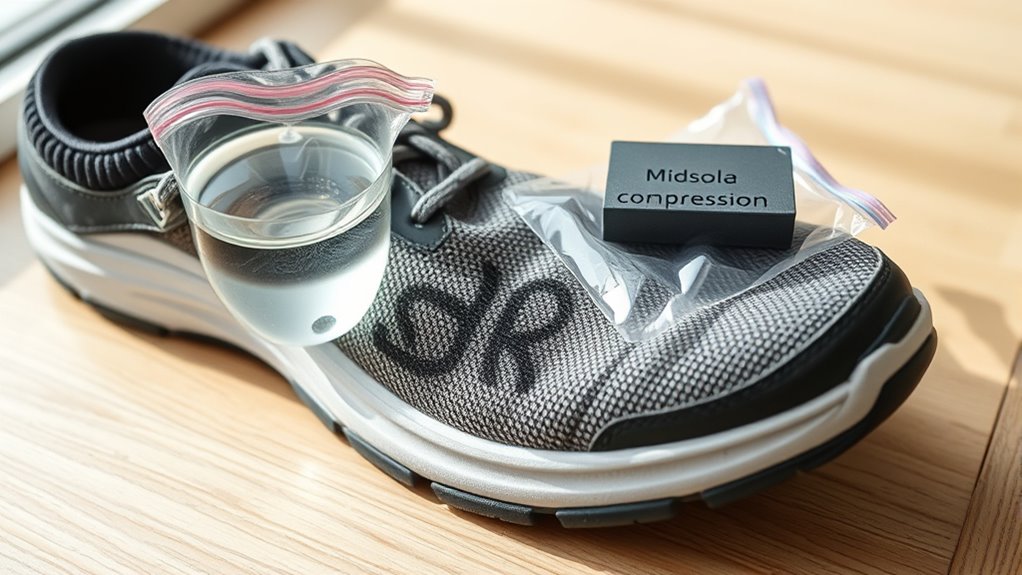
Proper maintenance can considerably extend the lifespan of your shoes, especially if you take proactive steps to care for them regularly. Regular shoe cleaning removes dirt and debris that can wear down materials, while sole polishing restores shine and creates a protective barrier. To keep your shoes in top shape, follow these tips:
| Tip | Action | Frequency |
|---|---|---|
| Shoe Cleaning | Wipe with a damp cloth | After each wear |
| Sole Polishing | Apply polish and buff | Every 2 weeks |
| Rotate Shoes | Avoid constant wear | Weekly |
| Store Properly | Use shoe trees or dust bags | When not in use |
Implementing these simple steps helps preserve cushioning and structural integrity, prolonging your shoes’ life.
Frequently Asked Questions
Can Midsole Compression Tests Be Done on All Types of Shoes?
You wonder if midsole compression tests work on all types of shoes. The answer is no, because material compatibility varies; some midsoles, like foam or gel, respond well, while others, such as rigid or specialized materials, pose testing limitations. Before testing, check your shoe’s material to guarantee accurate results. Not all shoes are suitable for these tests, so understanding your shoe’s construction helps you avoid misleading assessments.
How Often Should I Perform a Midsole Compression Test?
While it’s tempting to test your shoes often, doing midsole compression tests too frequently can wear them out prematurely. You should perform the test every 3 to 6 months, depending on how often you wear your shoes and your activity level. This testing frequency helps you monitor shoe longevity without compromising their structure. Keep an eye on comfort and support, and adjust testing intervals if you notice signs of wear sooner.
Are There Specific Brands Whose Midsoles Are Harder to Test?
You might notice that brand differences and material variations affect how easy it is to test midsoles. Some brands use denser or stiffer materials, making compression harder and less responsive to home tests. Conversely, shoes with softer midsoles are easier to evaluate. So, if you’re testing different brands, be aware that material choices can influence your results, requiring you to adjust your expectations or testing methods accordingly.
What Are Some Signs That a Compression Test Might Be Inaccurate?
When performing a compression test, watch for signs of inaccuracy like inconsistent results or unexpected readings. Material inconsistency in the midsole can skew your results, making them unreliable. Also, if you don’t use proper technique—like applying too much or too little pressure or not testing the same spot each time—your test may be inaccurate. Guarantee your method is consistent and the material is uniform for the best assessment.
Can I Repair a Worn Midsole Instead of Replacing the Shoes?
Did you know that nearly 70% of shoe wear occurs in the midsole? If your midsole material shows signs of compression or damage, repairing it could be an option. While some repair options, like adding cushioning inserts or using midsole fillers, can extend shoe life, they may not restore full support. Ultimately, consider the extent of wear; severe damage might still mean replacing your shoes for safety and comfort.
Conclusion
Think of your shoes as loyal companions on your journey. By performing simple compression tests at home, you’re giving them the check-up they deserve. Catching signs of wear early is like repairing a small crack before it splits wide open. With a little care and attention, you can extend their life and keep your steps steady. Treat your shoes well, and they’ll keep supporting you mile after mile.









